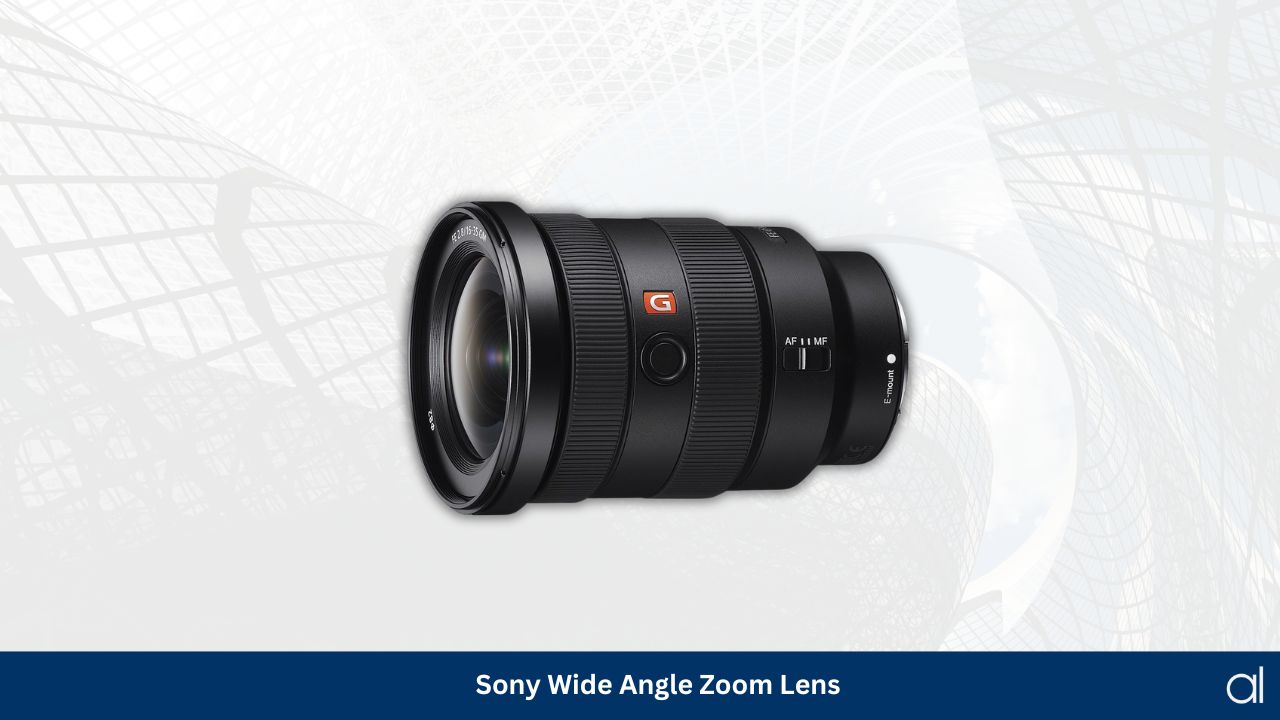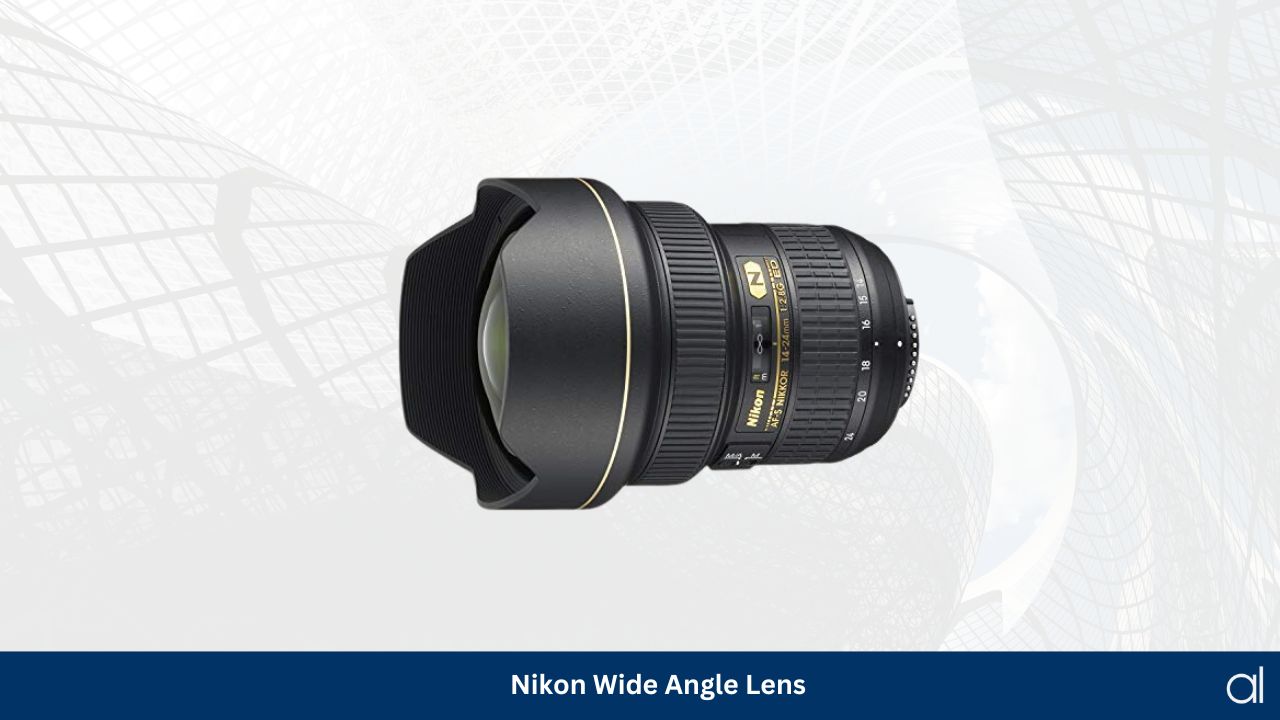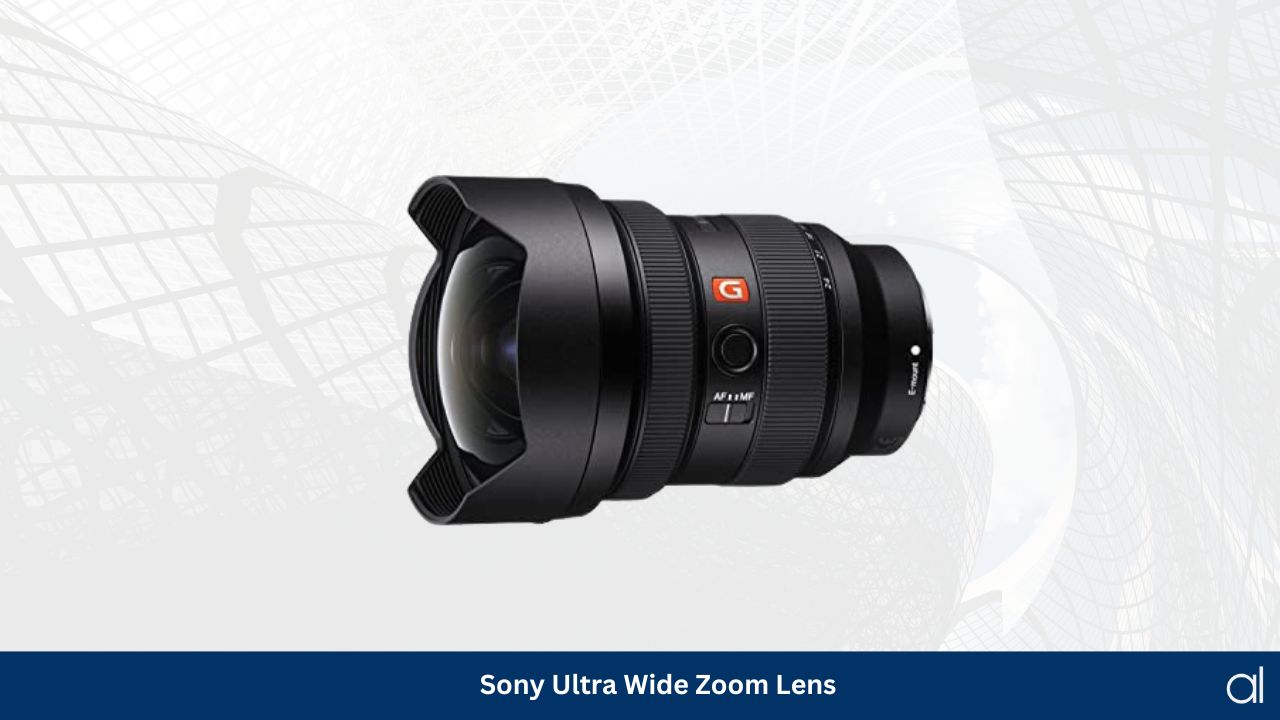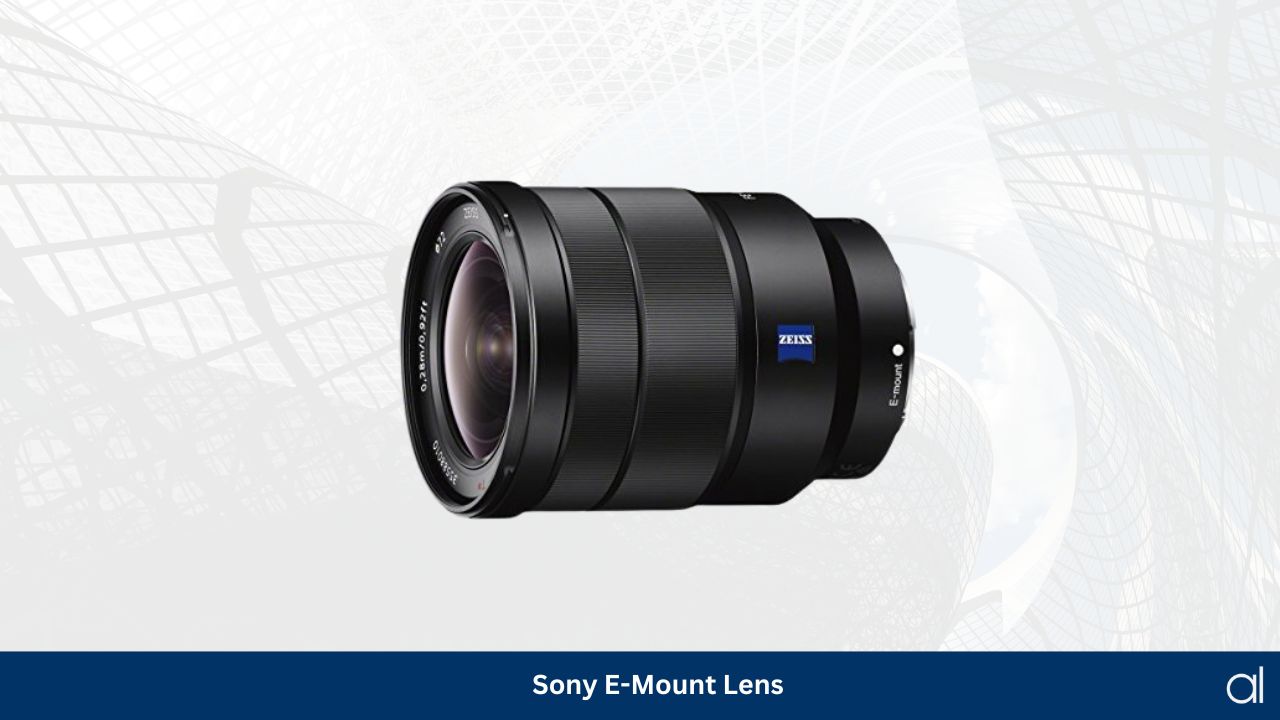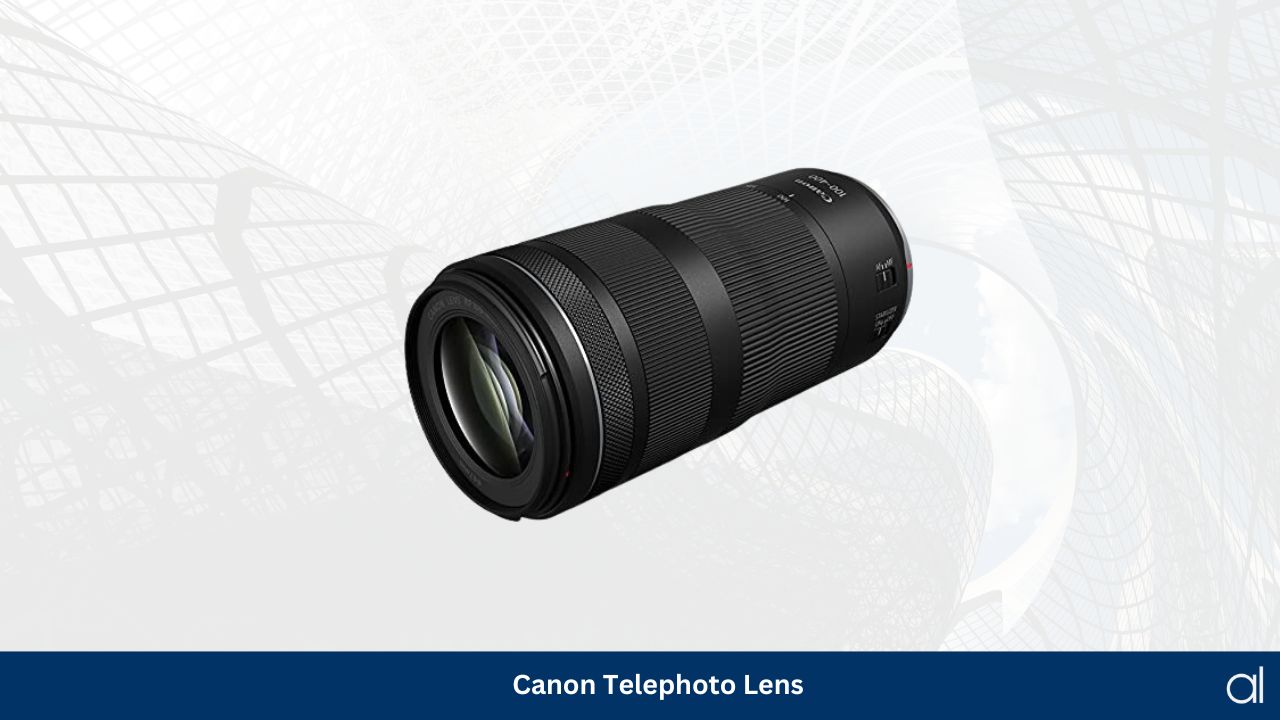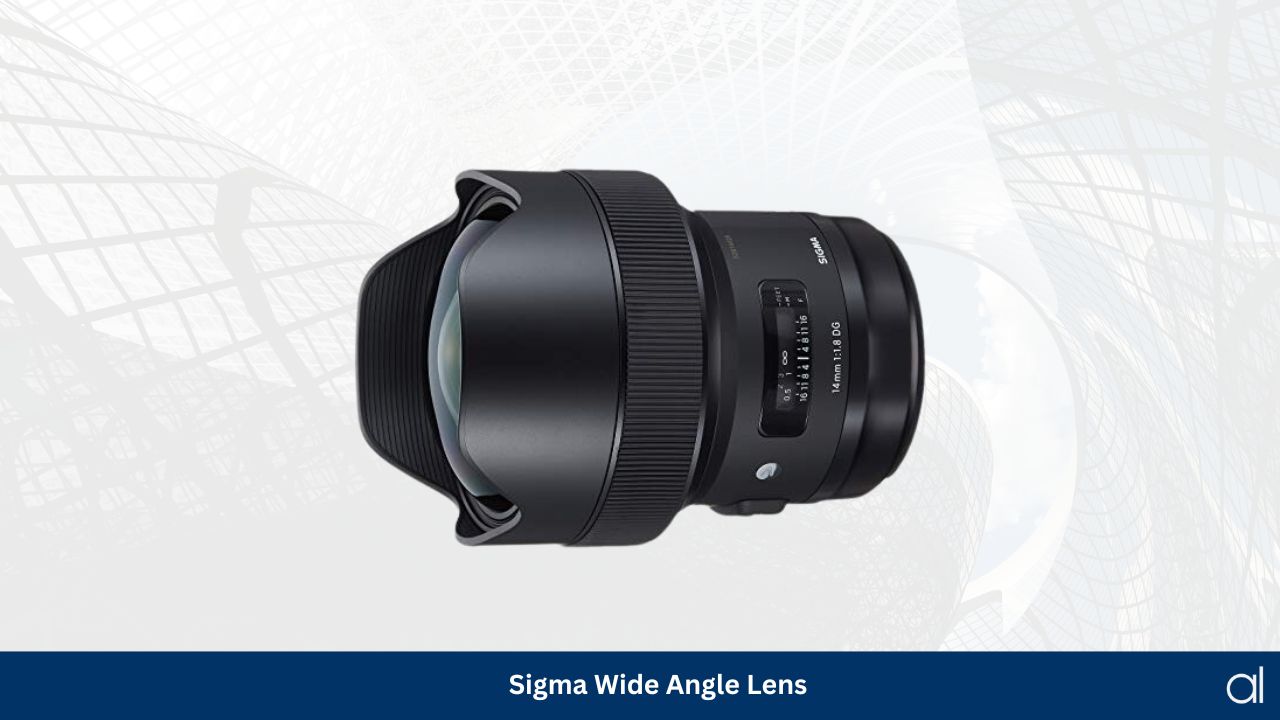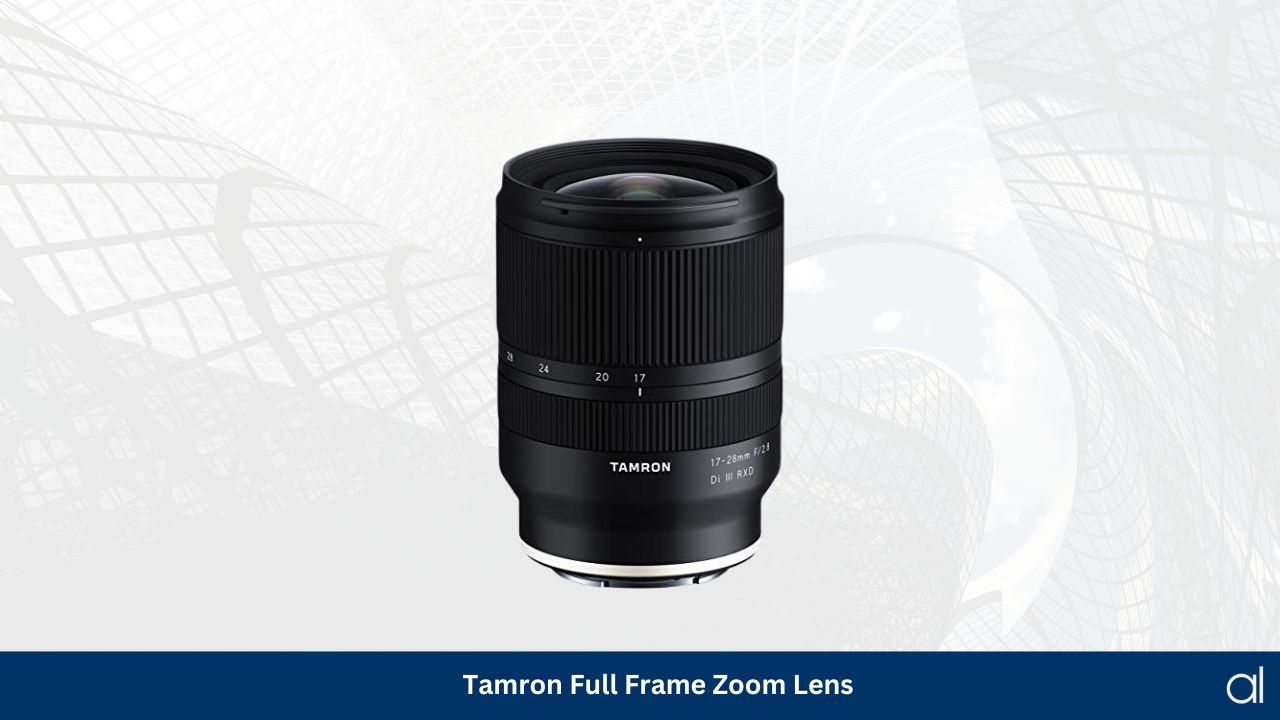One of the primary reasons architectural photography is so popular is due to its unlimited scope.
Almost every type of structure can be used as a subject, from the most iconic monuments to the most mundane and unexciting buildings, with extraordinary results. The only thing to pay attention to is the lens, which determines how well the pictures turn out.
This guide reviews some of the best lenses available for building photography in detail.
Best Lens for Building Photography
1. Sony Wide Angle Zoom Lens – Best Lens With G Master Design
A wide-angle lens with a maximum focal length of 35mm, the Sony Wide Angle Zoom Lens is an excellent option for those interested in building photography. It is designed to get 50 Line pairs/mm resolving power for the clearest shots and has two extreme aspherical (XA) elements that ensure that pictures are perfectly clear.
As indicated by my tests, this lens delivers high-resolution shots and superb contrast, making it ideal for architecture, landscape, and other subjects. The minimum focus distance is 0.28 m, which means that the angle of view is quite wide, allowing you to photograph a wide space.
For photographing tiny objects, the lens has a maximum magnification ratio (x) of -0.19, which is well-suited for capturing details on buildings. The Sony lens also has a constant F2.8 maximum aperture, which is very effective in maintaining proper depth of field and required exposure.
I also liked that there are 11 aperture blades for the most stringent control over the light entering the camera. This ensures subjects are well-lit but not over-exposed, so your shots look good in all situations.
Sony has created this lens with a G Master design, which further helps maintain good resolution while helping produce good bokeh.
The angle of view of this wide-angle lens ranges from 107 degrees to 63 degrees, and you get everything you need in the box. This includes a Sony E-mount, case, lens rear, and front caps, and hood for easy setup and storage.
What I Liked
- High resolution and contrast
- Lightweight
- Sharp and clear images
- Easy to use
What I Didn’t Like
2. Nikon Wide Angle Lens – Best Lens With Silent Wave Motor (SWM)
The Nikon wide-angle lens is another excellent option worth considering, with a focal length range of 14 to 24 mm, which is ideal for architecture photography. It has a minimum focus distance of 0.28 m, which is another reason this lens is great for taking pictures of buildings.
Also, I discovered through using this product that the minimum f/stop of the Nikon lens is 22. This means that the lens is highly efficient in controlling the amount of light required for lighting the subject, ensuring crisp pictures. It has also been optimized to provide edge-to-edge sharpness, even when using DX-format image sensors.
Another reason why the lens is such a highly recommended one among wide-angle lenses is its outstanding construction. It has been constructed using two ED glass elements, three aspherical lenses, and one Nano Crystal Coat. This coat helps reduce lens flare and ghosting while taking pictures, helping improve the picture quality even further.
The angle of view ranges from 114 to 84 degrees, so you won’t have difficulty capturing shots of different-sized buildings. Focusing on subjects is incredibly easy, thanks to the Silent Wave Motor (SWM), which maintains accuracy while allowing high-speed autofocusing.
In addition, the lens has a M/A focus mode switch, which makes switching between manual focus and autofocus easy. Similarly, the Internal Focus (IF) allows quick and quiet autofocusing without altering the lens length, and the high-quality construction keeps the lens protected against moisture and dust.
What I Liked
- Crisp picture quality
- Quick and easy operation
- High-quality construction
- Suitable for low-light photography
What I Didn’t Like
3. Sony Ultra Wide Zoom Lens – Best For Low-Light Photography
I’ve decided to include another lens from Sony here since it is among the best zoom lenses currently available, with a full-frame constant F2.8 at 12 to 24 mm. This ultra-wide zoom lens provides a wide angle of view and has advanced XD Linear Motors, making it a great choice for architectural photography.
The ultra-wide angle lens has a maximum aperture of f2.8, which helps provide the best depth of field and exposure, whether shooting landscapes or buildings. And with the 12 mm angle of view, it becomes easy to create impressive dynamics while effectively emphasizing distance.
Additionally, based on my first-hand experience, this allows the lens to be used even in low-light conditions with amazing results. The Sony ultra-wide zoom lens can be used in the most powerful cameras since its four XD Linear Motors allow quick tracking and autofocusing.
Furthermore, due to the three XA (extreme aspherical) elements that can combine with a single aspherical element, you can get the most stunning G Master resolution in architectural photography. Controlling the lens is also quite easy because of a floating focus mechanism that separates the focus group into two sections, each of which can be controlled independently.
This can be done through the lens controls, which include the Focus Mode Switch, Zooming ring, Focus Hold button, and Focusing ring. These controls and the moisture and dust-resistant design make it an ideal choice for both architectural and landscape photography.
What I Liked
- Clear, sharp images
- Lightweight
- Dust and moisture resistant
- Easy controls
What I Didn’t Like
4. Sony E-Mount Lens – Best Lens With Image Stabilization
With innovative features like Optical Steady Shot image stabilization, and support for the E-Mount from Sony, this Sony lens is the next item on this list. It is a popular choice among wide-angle lenses designed for landscape and architectural photography, compatible with the A7 series of full-frame cameras.
The lens comes with a ZEISS T coating that helps reduce ghosting and flare, helping you focus easily on the subject without distractions. Aside from that, it has a minimum focus distance of 0.28 m for capturing even wider areas with perfect clarity.
This is made even easier because of the maximum Magnification Ratio of 0.19x, while the focal length is ⅝-1-⅜ inches. I also discovered that the lens has 3 ED glass elements when I tried this product. These help maintain a constant f4 maximum aperture for the entire zoom range and reduce chromatic distortion and optical aberration.
Coming to the key feature of this lens, the Optical Steady Shot image stabilization helps maintain stability so that the shots are straight and pictures aren’t blurry. Aside from that, the 72 mm filter diameter of this lens makes it widely compatible with several types of filters.
Then there is the fact that this lens also has a moisture and dust-resistant design and is compatible with the Sony E (NEX) mountings. In addition, it comes with front and rear lens caps, a lens hood, and a case for easy storage and portability.
What I Liked
- ZEISS T star coating
- Image stabilization
- Wide photographic filter compatibility
- Lightweight
What I Didn’t Like
5. Canon Telephoto Lens – Best Lens With Compact Design
Canon is one of the best-known manufacturers of cameras and lenses, and this telephoto lens is an excellent offering from the brand. It is a lightweight and compact tele zoom lens with an incredible zoom range of 100 to 400 mm, ideal for capturing buildings in complete detail.
This camera lens also comes with an Optical Image Stabilizer and has up to 5.5 Stops that can be used for correcting blurry or unclear images. But I was even more impressed after trying this product and pairing it with an EOS R camera, which helps you get up to six stops of shake correction.
The Canon telephoto lens works with the InBody Image Stabilizer (IBIS) in such cameras to deliver the most stable and clear images possible. This is one feature that can help save a lot of time in making adjustments to get the perfect shot while avoiding blurriness.
At 200 m, the Canon telephoto lens has a minimum focusing distance of 0.88 m, while the maximum magnification is 0.41x at 400 m. So, you can rest assured that all types of buildings can be captured clearly
Another factor that helps in this is the Nano USM or ultrasonic motor used by Canon Inc. in this lens. This lens provides fast auto-focusing capabilities to the lens while ensuring noiseless and smooth operation, making it one of the best lenses for architectural photography.
Finally, the lightweight and compact design makes carrying the Canon lens easy.
What I Liked
- Versatile zoom range
- Image stabilization
- Smooth and fast performance
- Easy to carry
What I Didn’t Like
6. Sigma Wide Angle Lens – Best Lens With Multi-Layer Coating
Moving on to the next item, I bring you the Sigma wide-angle lens, which features a large diameter and wide angle of view. The large diameter of the lens allows f/1.8 brightness, helping you capture buildings and landscapes in great detail with minimal effort.
Additionally, this is among those camera lenses that can help you get the most beautiful bokeh effects, making it a good choice for architecture photographers. This is possible since the amount of light streaking across the lens can be easily controlled with this camera lens.
The ultrawide field of view is another highlight of the Sigma lens and allows capturing even the largest buildings and landscapes clearly, with perfect contrast and sharpness. Thus, it is incredibly easy to make the foreground or the subject the focus while contrasting it with the background for more impressive shots.
Also, based on my observations, I discovered that this lens has a super multi-layer coating that reduces ghosting and flares. Thus, the chances of problems like color bleeding, chromatic aberration, and distortion occurring are highly reduced.
For operation, the Sigma wide-angle lens relies on a large HSM (hypersonic motor) that provides a good amount of torque. This allows the lens to focus quickly but also helps it maintain perfect stability even when shooting at lower speeds.
And the lens comes with a cover lens cap, a rear cap, and a soft padded case, making it easy to carry or store.
What I Liked
- Easy to use
- Smooth and fast operation
- Great picture quality
- Well-built
What I Didn’t Like
7. Tamron Full Frame Zoom Lens – Best For Mirrorless Full Frame Cameras
Designed for Sony Mirrorless Full Frame cameras, the Tamron zoom lens claims to be the most lightweight camera lens with the largest aperture among wide-angle zoom lenses. While this alone makes it a worthy choice, several other features make it suitable for architectural photographers.
Despite being smaller than f4 lenses, this full-frame camera lens delivers unmatched image quality. One reason for that is the exceptionally quiet RXD stepping motor which helps you focus on the shot and eliminates distractions.
Apart from that, this lens comes with a fluorine coating, which repels oil and water and provides a moisture-resistant construction. Because of this, it is possible to use the lens in all weather conditions when photographing architecture without worrying about it getting damaged.
The Tamron lens can be used with 28-75 mm F2.8 Di III RXD cameras for getting the highest quality images, whether photographing interiors, exteriors, or landscapes. The reason is that lens length remains the same even while zooming. Using and handling the lens is also easy, as I discovered when I put it to everyday use.
Additionally, the filter diameter is the same as a standard lens, so you can conveniently use accessories like lens caps and filters like PL or polarizers. Lastly, the Tamron lens for mirrorless cameras comes with a six-year limited warranty, which means damage to it will be covered by the manufacturer. So, any replacements and refunds will be hassle-free, ensuring a great user experience.
What I Liked
- Noiseless operation
- Moisture-resistant construction
- Easy to use
- High-quality images
What I Didn’t Like
Top Lenses For Building Photography Comparison Table
| Camera Lenses | Lens Type | Maximum Aperture | Maximum Focal Length | Minimum Aperture |
|---|---|---|---|---|
| Sony Wide Angle Zoom Lens | Wide angle | f/2.8 | 35 mm | f/22 |
| Nikon Wide Angle Lens | Wide angle | f/2.8 | 24 mm | f/22 |
| Sony Ultra Wide Zoom Lens | Wide angle | f/2.8 | 24 mm | f/22 |
| Sony E-Mount Lens | Wide angle | f/4 | 35 mm | f/22 |
| Canon Telephoto Lens | Telephoto | f/5.6 | 400 mm | f/32 |
| Sigma Wide Angle Lens | Wide angle | f/1.8 | 14 mm | f/16 |
| Tamron Full Frame Zoom Lens | Zoom | f/2.8 | 28 mm | f/22 |
Buying Guide for the Best Lenses for Building Photography
While you now know about the best lenses available for architectural photography, choosing between them can be complicated. That’s why I’ve shared this buying guide here, listing some of the most important factors to consider when making a decision.
1. Focal Length
Both the perspective distortion and the angle of view are dependent on the focal length of a lens. This is denoted in millimeters and refers to the distance between the focus of a lens and its center. A shorter focal length means a wider field of view and vice versa.
When it comes to architectural photography, using wide-angle lenses with focal lengths ranging from 16 to 35 mm is best since they can effectively capture both exteriors and interiors. However, it is better to use lenses with focal lengths between 35 mm and 200 mm for more intricate or detailed shots.
2. Aperture
The aperture determines the amount of light entering the camera and is an essential factor affecting the depth of field. It is generally specified as an f-number, with camera lenses having several marked f-stops to which the aperture can be adjusted.
If the f-number is lower, the aperture has a larger opening, and more light can reach the camera sensor. A larger aperture can be used with a faster shutter speed, resulting in sharper images.
That said, it is better to use lenses with a narrow aperture for architectural photography due to the large size of buildings. A narrower aperture can ensure a deeper depth of field, so an ideal lens would have an aperture between f/8 and f/14.
3. Distortion Control
Image distortion is one of the most common problems when photographing buildings using wide-angle lenses. It is especially common with buildings having straight lines, in which case, using lenses with proper distortion control is required. Such lenses usually have aspherical elements or are specialized tilt-shift lenses used for tilt-shift photography.
A tilt-shift lens, also known as a perspective correction lens, allows a manual camera to behave like a technical camera, keeping the axis of the lens parallel to the ground. At the same time, the view can be shifted in the required direction, helping maintain perfectly vertical lines of the buildings.
4. Sharpness
Sharpness is a crucial factor to keep in mind when choosing a lens for architectural photography. A lens that excels in sharpness will allow for capturing fine details on a building, ensuring an overall clear image or video.
The crucial thing to remember here is that most lenses for DSLR cameras can be pretty sharp in the center but may lose their sharpness at the edges. That is why, even when selecting a lens for a full-frame DSLR, you should check that it is sharp, even at the edges of the frame.
5. Durability
When selecting a camera lens for architectural photography, consider the outdoor conditions in which you may need to take pictures. Almost all the lenses I’ve reviewed above feature durable construction and are dust and moisture-resistant.
This means they won’t get damaged when exposed to the elements and will also last longer, so you won’t need replacements soon.
6. Brand And Compatibility
Before deciding on gear like a camera lens, make sure to check your camera brand to ensure that the lens is compatible with it. Most brands offer several types of lenses, including telephoto lenses, macro lenses, fisheye lenses, anamorphic lenses, prime lenses, and ultra-wide lenses for their view camera models. However, their compatibility and interchangeability can vary significantly, so it is crucial to check them beforehand.
7. Price
Depending on whether you are a professional architectural photographer or a hobbyist, the price is another important consideration. For professionals, I recommend getting the best lens that their budget allows, while amateurs should consider how much they want to invest in this hobby.
Getting the right lens is extremely important to capture the best pictures, but camera lenses can be considerably expensive. So keep your budget in mind before making a decision.
What are lens elements?
Pieces of glass shaped specifically to bend light are called lens elements. Depending on the lens, several elements can be a part of it, which can be manufactured using different techniques. Some of these elements are movable, while others are movable, and both help in image stabilization, focusing, and zooming for the perfect photograph.
Optical glass material may be ground into a semicircular shape resulting in a spherical lens element. Alternatively, the glass material can be press-formed at high pressure and temperature to get an aspherical element.
Can you use an anamorphic lens for architectural photography?
Anamorphic lenses are a special type of camera lens that can take in light and project it onto the image sensor at a different angle. They are designed to provide a wider field of view while using a narrow sensor, making for the most cinematic shots. Because of this reason, they can be used for architectural photography.
Which lens should you use for interior shots in real estate photography?
To capture interiors perfectly, the best lens would be a wide-angle one with a focal length between 16 and 35 mm. You can also use a fisheye lens or a macro one for such purposes, and some photographers even rely on an anamorphic lens to get the best shots. However, you need to keep a few things in mind when using these lenses.
Firstly, the ISO should be kept as low as possible, such as close to 100. Similarly, the aperture range should lie between f/8 to f/11, except where a shallow depth of field is required and a prime lens has to be used. The shutter speed can be between two and eight seconds.
Is a 50mm lens good for photographing architectural structures?
A 50 mm lens can help you get some good shots when photographing buildings, but it may not always be the best option in all situations. For instance, sometimes you may need a longer or wider focal length, in which case this may not be the perfect lens to use.
Which type of lens causes minimal distortion?
Prime lenses tend to cause little distortion and generally have constant wide apertures. This is because they do not have moving parts that cause diffraction. Because of this, they are one of the best lenses for architectural photography.
Conclusion
Selecting the right lens can be tricky, especially if you are a novice and have little expertise. But hopefully, with the help of this guide, you may find the process a bit easier. Just make sure to pay attention to the factors mentioned in the buying guide when making a decision.
With that said, it is time to conclude this review, but before that, I’d like to share a few of my favorites from the list here. The Sony Wide Angle Zoom Lens has a maximum focal length of 35mm and two extreme aspherical elements, making it ideal for architectural and landscape photography.
Similarly, the Nikon Wide Angle Lens, with its minimum f stop of 22 and edge-to-edge sharpness, is well-suited for shooting both interiors and exteriors of buildings.

